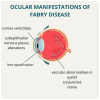Anderson-Fabry Disease: Focus on Ophthalmological Implications
- PMID: 39768240
- PMCID: PMC11676308
- DOI: 10.3390/life14121531
Anderson-Fabry Disease: Focus on Ophthalmological Implications
Abstract
Fabry disease (FD) is a rare X-linked lysosomal storage disorder with a broad spectrum of clinical manifestations, including severe complications, such as end-stage renal disease, hypertrophic cardiomyopathy, and cerebrovascular disease. Enzyme replacement therapy (ERT), when initiated early, has been shown to reduce the incidence of severe events and slow disease progression. In the classic form, characterized by the absence of α-galactosidase A (α-Gal A) enzyme activity, diagnosis is straightforward. However, when residual activity is present, the delayed and less obvious presentation can make diagnosis more challenging. Ophthalmological alterations, which can be detected through non-invasive examinations may play a crucial role in correctly assessing the patient in terms of diagnosis and prognosis, particularly in these atypical cases. Recognizing these ocular signs allows for timely intervention with ERT, leading to improved patient outcomes. This review highlights the importance of ophthalmological findings in FD, emphasizing their role in diagnosis and treatment planning. By raising awareness among ophthalmologists and healthcare specialists, this review aims to improve disease management, offering tools for early detection and better long-term prognosis in patients with FD.
Keywords: Fabry disease; angio-OCT; confocal microscopy; cornea verticillata; enzyme replacement therapy; lysosomal storage disorder; retinal vessel density; vessel tortuosity.
Conflict of interest statement
The authors declare no conflict of interest.
Figures




References
Publication types
LinkOut - more resources
Full Text Sources

